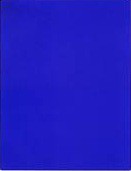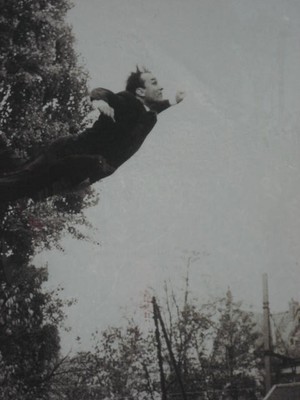Out of the Blue

- SUBSCRIBE
- ALREADY SUBSCRIBED?
BECOME A BONJOUR PARIS MEMBER
Gain full access to our collection of over 5,000 articles and bring the City of Light into your life. Just 60 USD per year.
Find out why you should become a member here.
Sign in
Fill in your credentials below.
Essential, potential, absolute, unstable, static, dynamic, pure, prestigious, impregnated, immaterial, exasperating, wonderful. This is a partial list of adjectives coined by one man to describe not a woman, but a color. That man was Yves Klein, one of the most influential artists of the twentieth century. And the color was International Klein Blue (IKB).

The Hirshhorn Museum in Washington DC is giving visitors a taste of the 1960s art scene in Paris with its major retrospective of French-born artist Yves Klein (1928-1962). Klein dabbled in painting, sculpture, performance, photography, music, architecture, writing and video, and whatever he undertook was marked by his uncommon spirit and sensibility. He was a man who knew no boundaries; an artist whose peers found him “impossible to classify”. His short but prolific career set the stage for conceptual and avant garde art.
But back to the blue. International Klein Blue, to be exact. What sort of person would have the audacity to take out a patent on one of the colors of the rainbow? The same person who wrote to the International Atomic Commission of his day to suggest in all seriousness that they color their atom bombs with IKB! In order to understand Klein’s obsession with blue it is essential to grasp his philosophy regarding Art and Life. He strove relentlessly to capture the immaterial, professing his ultimate desire to make ‘art be one with life’. For Klein, the color blue represented the void, the largesse of the sea and sky. Blue is not confined by dimensions, it simply “is”. Klein’s IKB was the result of experimentation to distill the infinite into a physical pigment, which he then used to cover his canvases, sponge installations and numerous other objets. His most identifiable paintings were created by ‘living paintbrushes’ – nude models who would roll around in his blue pigment, pressing their bodies against canvas to leave their imprints.

Klein lived in Paris at a pivotal time of social upheaval, where existing mores were being demolished one by one. In fact he called his work “The Blue Revolution”. One of his favorite watering holes was La Coupole brasserie in the 14th arrondissement, where he would spend evenings with fellow artists and intellectuals conjuring up new ways to capture reality and eventually penning a Manifesto of New Realism. Klein was fortunate to be living in a time and place where the art world was ripe for his eccentric ideas and concepts. Paris welcomed his outlandish ideas with open arms – one gallery exhibited floor to ceiling garbage which Klein collected from the streets of Paris; another opened an exhibition which consisted of…nothing! His endeavor to push the envelope led him to attempt to actually master air and put his signature on the sky, as represented in his brilliant photomontage Leap into the Void.

The Hirshhorn Museum’s retrospective left me with a palpable sense of Yves Klein’s almost manic passion for his art and his purpose in life. It is difficult to describe the vibrations which his blue emits. Intense and opaque, like liquid velvet. One of the works on display was like a giant swimming pool filled with IKB pigment. It was hard to resist the urge to dive right in. Klein’s fire paintings were equally fascinating, as were his nonsensical videos. In all, the works represented a truly unique figure in the history of twentieth century art. The National Museum of Modern Art and the Pompidou Center are amongst the institutions in Paris that boast works by Yves Klein in their permanent collections.
During his lifetime, some critics considered him insane while others thought him a genius. Ultimately, his works have stood the test of time, bearing witness to a mind constantly, almost painfully, searching for the next dimension to conquer. In retrospect, Klein’s iconic Leap into the Void foreshadowed his untimely death of a heart attack at age 34. But rather than seeming tragic, I imagine Klein lived an incredibly exciting and fulfilling life to the very last moment, adhering to his own credo that “if something marvelous does not happen to me every day, my world is shot.” Chapeau!
If you’re coming to France (or for that matter anywhere) you can reserve your hotel here. To rent a car, Bonjour Paris recommends Auto Europe.
More in Art, Bonjour Paris, French artists, Museum, Paris


